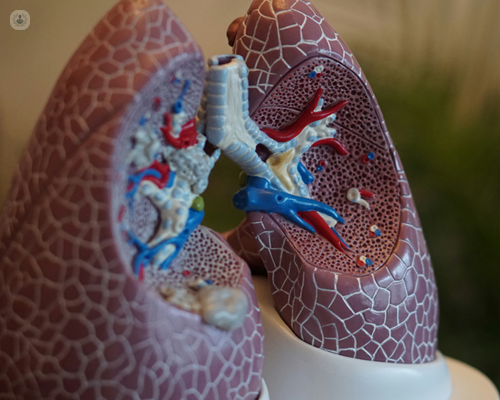Robotic surgery for lung tumours
Written in association with:Robotic surgery is an innovative approach that is transforming the treatment of lung tumours. This advanced technique allows for greater precision and control, enabling surgeons to perform minimally invasive procedures with enhanced accuracy. For patients with lung cancer, robotic surgery offers several benefits, including smaller incisions, reduced recovery time, and fewer complications compared to traditional open surgery.

What is robotic surgery for lung tumours?
Robotic surgery, also known as robot-assisted thoracic surgery, involves the use of a robotic system to perform delicate procedures inside the chest. The surgeon controls the robot’s movements from a console, guiding its arms to perform complex tasks with high precision. The robotic system is equipped with a 3D high-definition camera, allowing the surgeon to view the area in detail, and specialised instruments that can make very fine movements.
This method is particularly useful in treating lung tumours, as it allows for greater precision in removing the tumour while preserving as much healthy lung tissue as possible.
How is robotic surgery different from traditional surgery?
Unlike traditional open surgery, where a large incision is made in the chest, robotic surgery uses small incisions through which the robot's arms and camera are inserted. This minimally invasive approach results in:
- Less trauma to the body
- Reduced blood loss
- Lower risk of infection
- Shorter hospital stays
- Faster recovery times
- Less post-operative pain
The enhanced control and flexibility of the robotic instruments allow surgeons to perform more complex procedures with greater ease and precision.
Who is a candidate for robotic lung surgery?
Robotic surgery for lung tumours is suitable for many patients, but it may not be appropriate for everyone. Candidates for this type of surgery typically include those with early-stage lung cancer or benign lung tumours that can be removed through a minimally invasive approach. Other factors, such as the size and location of the tumour and the patient's overall health, will be considered by the surgeon when deciding if robotic surgery is the best option.
What are the benefits of robotic surgery for lung tumours?
Robotic surgery offers several advantages over traditional open surgery, particularly for patients with lung tumours. These include:
- Precision: The robotic system allows for extremely precise movements, enabling the surgeon to remove the tumour while minimising damage to surrounding tissue.
- Smaller incisions: The use of small incisions reduces the risk of complications such as infections and blood loss.
- Quicker recovery: Patients who undergo robotic surgery generally experience less post-operative pain and a faster recovery than those who have traditional open surgery.
- Shorter hospital stay: Many patients are able to leave the hospital within a few days after robotic surgery, compared to the longer hospital stays required for open surgery.
What is the recovery process like after robotic lung surgery?
The recovery process following robotic lung surgery is typically faster than with traditional surgery. Patients can expect:
- A shorter hospital stay, often around 3-5 days
- Less post-operative pain due to smaller incisions
- A quicker return to normal activities, usually within a few weeks
While the recovery time may vary depending on the individual and the complexity of the surgery, most patients find that they can resume their daily activities more quickly compared to traditional open surgery.
Are there any risks associated with robotic surgery?
As with any surgery, there are risks associated with robotic lung surgery, although they are generally lower than those associated with open surgery. Potential risks include:
- Infection
- Bleeding
- Complications from anaesthesia
- Damage to surrounding organs or tissues
However, the precision of robotic surgery typically reduces these risks compared to traditional surgery.
Robotic surgery is revolutionising the treatment of lung tumours by providing surgeons with a high level of precision and control. For patients, this translates to fewer complications, faster recovery times, and better overall outcomes. While not suitable for everyone, robotic surgery offers a promising option for many individuals diagnosed with lung cancer, allowing for effective treatment with less disruption to their lives.


